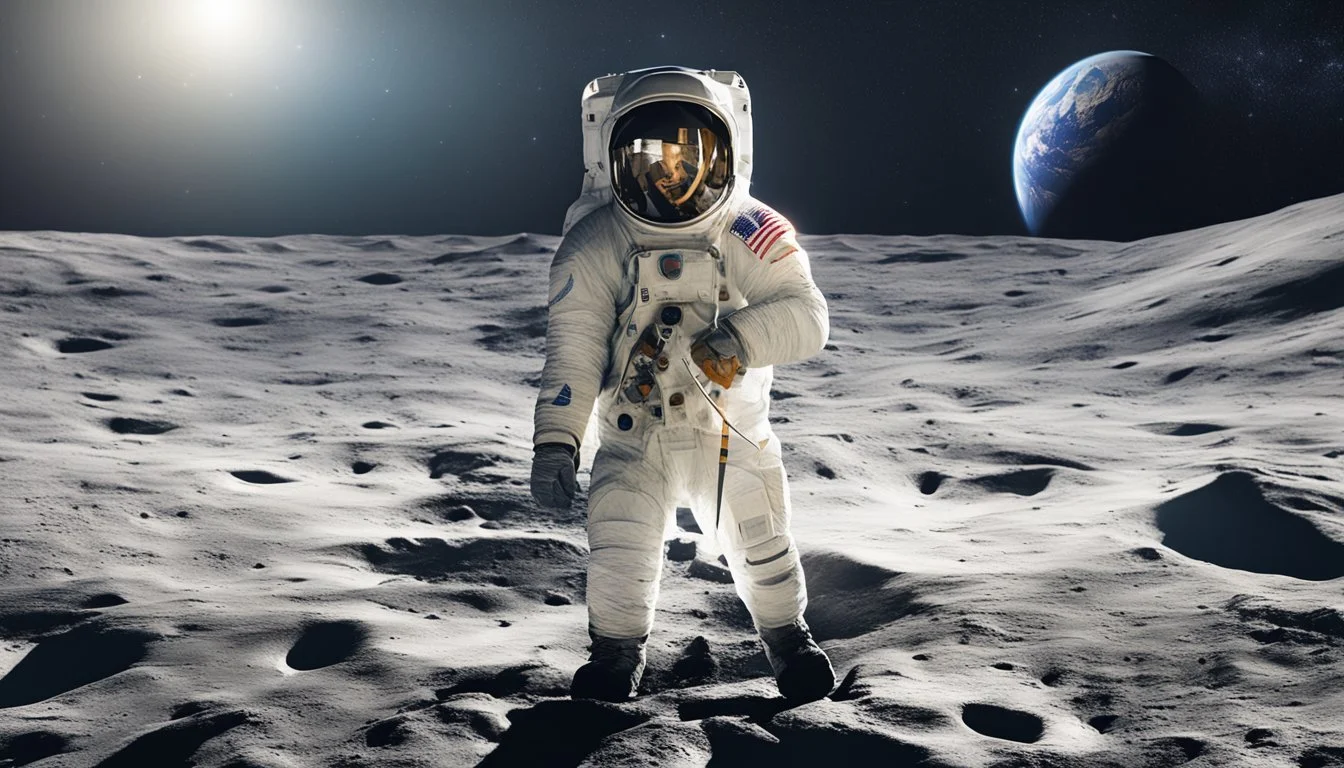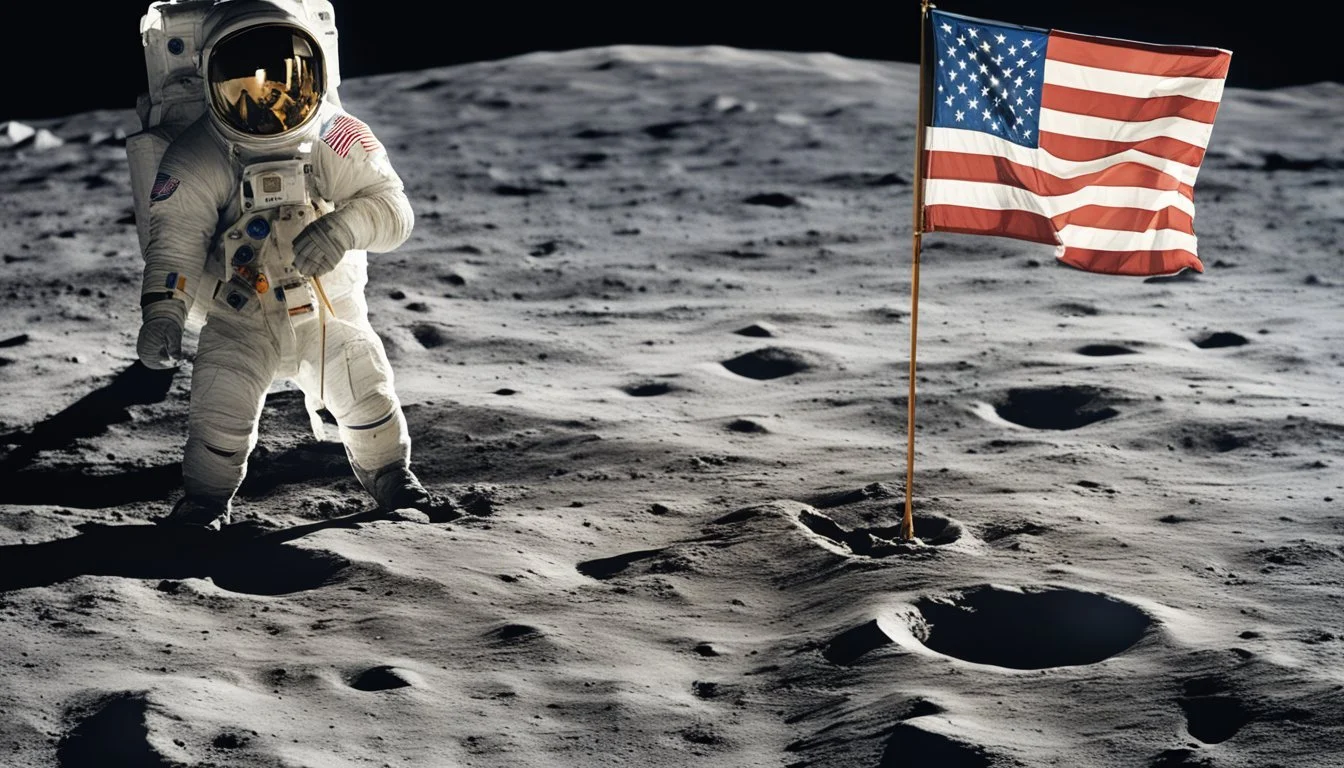Defying Gravity: The True Story of "First Man" Neil Armstrong
From Test Pilot to Lunar Pioneer
Neil Armstrong's journey to become the first human to set foot on the Moon is a tale of determination, courage, and scientific achievement. The 2018 film "First Man" brings this remarkable story to life, depicting Armstrong's personal struggles and professional triumphs during the space race era. While the movie takes some creative liberties, it largely stays true to the historical events that led to the Apollo 11 mission.
The film portrays Armstrong's experiences as a test pilot, his selection for the Gemini program, and the challenges he faced during his NASA career. It captures pivotal moments like the Gemini 8 mission, where Armstrong successfully performed the first docking in space, and the tragic Apollo 1 fire that claimed the lives of his colleagues. These events shaped Armstrong's character and fueled his determination to reach the Moon.
"First Man" also explores Armstrong's personal life, including the loss of his young daughter and the strain his career put on his family. While some scenes were altered for dramatic effect, the film's core narrative remains faithful to Armstrong's story. It offers viewers a glimpse into the emotional and physical demands placed on astronauts during one of humanity's greatest adventures.
Early Life and Education of Neil Armstrong
Neil Armstrong's journey to becoming the first person to walk on the moon began in small-town Ohio. His early fascination with flight, academic pursuits in aeronautical engineering, and naval service shaped the skills and mindset that would propel him to make history.
Childhood and Formative Years
Neil Alden Armstrong was born on August 5, 1930, in Wapakoneta, Ohio. He grew up in several small Ohio towns as his father moved for work. At age 6, Armstrong experienced his first airplane ride, sparking a lifelong passion for aviation.
As a boy, he was active in the Boy Scouts, achieving the rank of Eagle Scout. Armstrong built model airplanes and conducted experiments in a makeshift wind tunnel in his bedroom. His curious and analytical nature was evident from an early age.
In high school, Armstrong excelled in science and mathematics. He obtained his student pilot's license before he could legally drive a car, demonstrating his dedication to flying.
Pursuit of Aeronautical Engineering
Armstrong entered Purdue University in 1947 on a U.S. Navy scholarship. He chose to study aeronautical engineering, aligning his academic path with his passion for flight.
At Purdue, Armstrong maintained a rigorous course load and participated in the university's flight program. He gained valuable hands-on experience with aircraft, further honing his skills as a pilot.
His studies were interrupted by the Korean War, but he returned to complete his bachelor's degree in 1955. Armstrong's time at Purdue laid the foundation for his future career in aviation and space exploration.
Naval Service and Korean War Experience
In 1949, Armstrong was called to active duty in the U.S. Navy. He trained as a naval aviator, earning his wings in 1950. During the Korean War, Armstrong flew 78 combat missions in F9F Panther jets.
Key achievements during his naval service:
Youngest pilot in his squadron
Awarded three Air Medals
Ejected safely from a damaged aircraft
Armstrong's combat experience honed his flying skills and ability to perform under pressure. These qualities would prove invaluable in his future role as an astronaut.
After the war, he served as a test pilot for the Navy before returning to complete his degree at Purdue.
Armstrong's Path to NASA
Neil Armstrong's journey to NASA was marked by his exceptional skills as a test pilot and his unwavering dedication to aviation. His experiences and achievements paved the way for his selection to the space program and eventual role in the historic Apollo 11 mission.
Test Pilot Tenure
Armstrong began his career as a naval aviator, serving in the Korean War. After completing his service, he joined the National Advisory Committee for Aeronautics (NACA), NASA's predecessor, as a test pilot in 1955.
At NACA, Armstrong flew cutting-edge aircraft, including the X-15 rocket plane. He pushed the boundaries of flight, reaching altitudes of over 200,000 feet and speeds exceeding Mach 5.
His expertise in handling experimental aircraft and ability to remain calm under pressure made him an ideal candidate for space exploration.
Joining the Astronaut Corps
In 1962, Armstrong applied to NASA's second group of astronauts. He was one of only two civilian pilots selected among the "New Nine" astronauts chosen that year.
Armstrong's background as a test pilot and engineer made him a valuable addition to the space program. His selection marked the beginning of his journey towards becoming the first man on the moon.
NASA recognized Armstrong's potential and technical skills, which would prove crucial in the complex missions ahead.
Gemini Program Contributions
Armstrong's first spaceflight came in 1966 as command pilot of Gemini 8. The mission aimed to perform the first docking of two spacecraft in orbit.
Despite encountering a critical malfunction that caused the capsule to spin uncontrollably, Armstrong remained composed. He successfully stabilized the spacecraft and brought it safely back to Earth.
This incident demonstrated Armstrong's exceptional piloting skills and ability to handle emergencies in space. His performance on Gemini 8 further solidified his reputation as a skilled and reliable astronaut, setting the stage for his future role in the Apollo program.
The Apollo 11 Mission
Apollo 11 marked a pivotal moment in human history as the first mission to land astronauts on the Moon. The mission captured global attention and showcased the culmination of years of scientific and engineering efforts.
Preparation and Training
NASA selected Neil Armstrong, Buzz Aldrin, and Michael Collins for the Apollo 11 crew. The astronauts underwent rigorous training to prepare for their lunar voyage.
They spent countless hours in simulators, practicing every aspect of the mission. This included lunar landing procedures and moonwalk protocols.
The team also trained for potential emergencies and equipment failures. Geological training helped prepare Armstrong and Aldrin for their exploration of the lunar surface.
Launch and Voyage to the Moon
On July 16, 1969, Apollo 11 lifted off from Kennedy Space Center atop a Saturn V rocket. Millions watched the launch on television, witnessing the start of the historic journey.
The spacecraft entered Earth orbit and then began its transit to the Moon. During the three-day voyage, the crew performed course corrections and prepared for lunar orbit insertion.
On July 19, Apollo 11 entered lunar orbit. The next day, Armstrong and Aldrin boarded the Lunar Module Eagle, separating from the Command Module Columbia piloted by Collins.
Historic Moon Landing
Eagle descended to the lunar surface on July 20, 1969. Armstrong manually piloted the lander, avoiding boulder-strewn areas to find a suitable landing site.
At 20:17 GMT, Armstrong announced, "The Eagle has landed." Hours later, at 02:56 GMT on July 21, he became the first human to step onto the Moon.
Armstrong's famous words, "That's one small step for man, one giant leap for mankind," were broadcast worldwide. Aldrin joined him shortly after, and together they spent about 2.5 hours exploring the lunar surface.
The astronauts collected samples, took photographs, and conducted scientific experiments. They also planted the U.S. flag and left behind commemorative items.
Return to Earth
After 21 hours on the Moon, Eagle lifted off to rejoin Columbia in lunar orbit. The ascent was successful, and the crew began their journey back to Earth.
The return voyage lasted three days. On July 24, the Command Module separated from the Service Module and reentered Earth's atmosphere.
Apollo 11 splashed down in the Pacific Ocean at 16:50 GMT. The crew was recovered by the USS Hornet and placed in quarantine as a precaution against potential lunar pathogens.
The mission's success fulfilled President Kennedy's goal of landing a man on the Moon and returning him safely to Earth before the end of the 1960s.
Post-Lunar Life of Neil Armstrong
Neil Armstrong's life after the Apollo 11 mission was marked by significant academic contributions and selective public engagements. He leveraged his unique experiences to advance aerospace education and occasionally shared insights about his historic lunar journey.
Academic Tenure
Armstrong joined the University of Cincinnati as a professor of aerospace engineering in 1971. He taught for eight years, focusing on aircraft design and experimental flight mechanics. His practical experience as a test pilot and astronaut enriched the curriculum.
Armstrong's research concentrated on improving aircraft performance and safety. He collaborated with colleagues on projects related to flight control systems and aerodynamics. His presence on campus inspired a new generation of aerospace engineers.
In 1979, Armstrong stepped down from his full-time teaching position but maintained connections with the university as a researcher and advisor.
Public Engagements and Contributions
Armstrong carefully chose his public appearances after Apollo 11. He served on corporate boards, including Marathon Oil and United Airlines, lending his expertise to the business world.
In 1986, Armstrong joined the Rogers Commission, investigating the Challenger disaster. His insights were crucial in understanding the technical aspects of the tragedy.
Armstrong occasionally gave interviews about the moon landing. In a 2011 appearance, he provided personal commentary on Apollo 11's historic achievement and shared thoughts on leadership.
He also participated in select space advocacy efforts, testifying before Congress on NASA's future direction. Armstrong's measured public presence maintained his reputation as a humble yet influential figure in spaceflight history.
Legacy of Neil Armstrong
Neil Armstrong's historic first step on the Moon left an indelible mark on human history. His achievements and character continue to inspire generations long after the Apollo 11 mission.
Impacts on Space Exploration
Armstrong's lunar landing paved the way for future space exploration. His successful mission demonstrated the feasibility of human spaceflight beyond Earth orbit. This accomplishment spurred further Apollo missions and international space programs.
Armstrong's expertise as a test pilot and engineer also contributed to spacecraft design improvements. His feedback on the Lunar Module helped refine its systems for subsequent missions.
After retiring from NASA, Armstrong served on accident investigation panels. His insights from the Apollo 1 fire and Challenger disaster helped enhance space travel safety protocols.
Cultural Influence
Armstrong became a global icon of exploration and scientific achievement. His famous words "That's one small step for man, one giant leap for mankind" resonated worldwide.
The Apollo 11 mission united people across nations in a shared sense of wonder. Television broadcasts of the moonwalk were watched by an estimated 600 million people.
Armstrong's humility and dedication inspired many to pursue careers in science and engineering. Numerous schools, research centers, and space facilities now bear his name.
His life story has been depicted in books, films, and documentaries. The 2018 biopic "First Man" brought renewed attention to Armstrong's personal journey.
Awards and Honors
Armstrong received numerous accolades for his contributions to space exploration. These included:
Presidential Medal of Freedom (1969)
Congressional Space Medal of Honor (1978)
Congressional Gold Medal (2009)
He was inducted into the U.S. Astronaut Hall of Fame in 1993. Armstrong also received honorary doctorates from several universities.
The lunar crater Armstrong was named in his honor. In 2012, NASA renamed a lunar orbiter facility the Neil A. Armstrong Flight Research Center.
Despite his fame, Armstrong remained modest about his achievements. He often emphasized the collective effort behind the Apollo program's success.
Armstrong's Personal Life
Neil Armstrong was a private man who valued family and had diverse interests beyond his astronaut career. His personal life was marked by both triumphs and tragedies that shaped him as a person and professional.
Family and Relationships
Neil Armstrong married Janet Shearon in 1956. They had three children together: Eric, Karen, and Mark. Tragically, Karen died at age two from a brain tumor, deeply impacting the family. Armstrong was known to be a devoted father, though his intense focus on work sometimes strained family relationships.
In 1994, Armstrong and Janet divorced after 38 years of marriage. He later married Carol Knight in 1994, finding companionship in his later years.
Armstrong maintained close friendships with fellow astronauts, particularly those from the Gemini and Apollo programs. These bonds were forged through shared experiences and challenges unique to their profession.
Hobbies and Personal Interests
Outside of his NASA duties, Armstrong pursued various hobbies and interests. He was an avid pilot, owning several private aircraft and flying regularly for pleasure. This passion for aviation extended beyond his professional life.
Armstrong had a keen interest in science and engineering. He enjoyed tinkering with machines and solving complex problems. Reading was another favorite pastime, with a particular fondness for science fiction and history books.
Music played a significant role in Armstrong's life. He played the baritone horn in his youth and maintained an appreciation for classical music throughout his life. Armstrong also enjoyed outdoor activities like fishing and golfing, which provided a respite from his high-pressure career.
Analysis of Biographical Accounts
Neil Armstrong's life has been chronicled through various literary works and visual media. These accounts offer diverse perspectives on the astronaut's journey and achievements.
Literature and Biographies
James R. Hansen's "First Man: The Life of Neil A. Armstrong" stands as the definitive authorized biography. Published in 2005, it provides an in-depth look at Armstrong's life, drawing from extensive interviews with the astronaut himself. The book explores Armstrong's childhood, his naval career, and his time as a test pilot.
Other notable works include "Neil Armstrong: A Life of Flight" by Jay Barbree, which focuses on Armstrong's aviation career. "Moonshot: The Inside Story of America's Race to the Moon" by Alan Shepard and Deke Slayton offers a broader perspective on the Apollo program, including Armstrong's role.
Documentaries and Films
The 2018 film "First Man," directed by Damien Chazelle and starring Ryan Gosling, brought Armstrong's story to the big screen. Based on Hansen's biography, it aimed for historical accuracy in depicting the astronaut's personal and professional life. The movie received praise for its attention to technical details and emotional depth.
Several documentaries have also explored Armstrong's life. "Neil Armstrong: First Man on the Moon" (2012) by BBC features interviews with family members and fellow astronauts. "Armstrong" (2019), narrated by Harrison Ford, uses archival footage and voice recordings to tell Armstrong's story in his own words.
Technological Advances Influenced by Armstrong's Career
Neil Armstrong's contributions to aeronautics and space exploration sparked numerous technological advances. His work as a test pilot and astronaut pushed the boundaries of aviation and spaceflight technology.
Armstrong's involvement in the X-15 hypersonic aircraft program led to improvements in high-speed flight. The X-15 reached speeds over Mach 6, paving the way for future supersonic and hypersonic aircraft designs.
In the Gemini program, Armstrong helped refine spacecraft rendezvous and docking techniques. These skills proved crucial for later lunar missions and space station operations.
The Apollo program accelerated developments in:
Lightweight, heat-resistant materials
Miniaturized computer systems
Life support technologies
Propulsion systems
Armstrong's lunar landing showcased advancements in guidance, navigation, and control systems. These technologies found applications in satellite technology and precision GPS.
Post-NASA, Armstrong continued to influence aerospace technology as a corporate consultant. His expertise shaped aircraft design and safety improvements across the aviation industry.
The space race inspired by Armstrong's achievements spurred innovations in:
• Telecommunications • Weather forecasting • Remote sensing • Medical imaging
These technologies have since become integral parts of everyday life, demonstrating the far-reaching impact of Armstrong's career on technological progress.
Reflections on Space Policy and Future Missions
Neil Armstrong's historic moon landing sparked a new era of space exploration. His achievement inspired generations of scientists, engineers, and dreamers to push the boundaries of human knowledge.
In the decades since Apollo 11, space policy has evolved significantly. NASA's focus shifted from lunar missions to the Space Shuttle program and the International Space Station.
The landscape of space exploration has changed dramatically. Private companies like SpaceX and Blue Origin now play major roles alongside government agencies.
Current space policies emphasize returning humans to the moon and eventually reaching Mars. NASA's Artemis program aims to land the first woman and next man on the lunar surface by 2025.
International cooperation has become increasingly important in space endeavors. The ISS serves as a prime example of nations working together to advance scientific research in orbit.
Future missions face both exciting possibilities and significant challenges:
Establishing permanent lunar bases
Developing technologies for long-duration space travel
Exploring the potential for asteroid mining
Searching for signs of extraterrestrial life
As humanity looks to the stars, Armstrong's small step remains a powerful symbol of what can be achieved through dedication, innovation, and collective effort.







